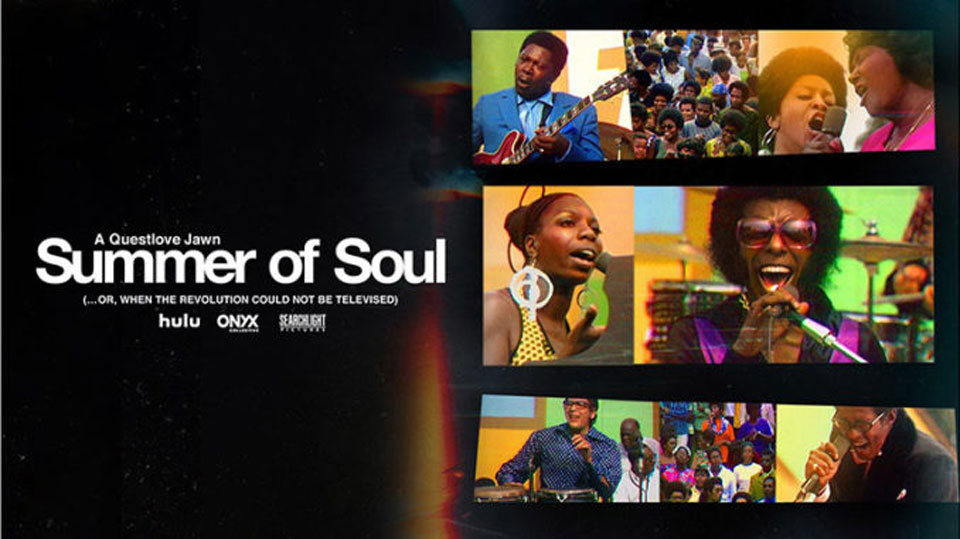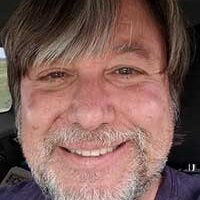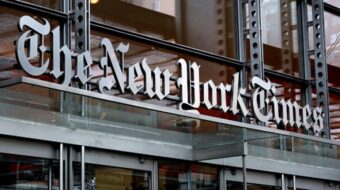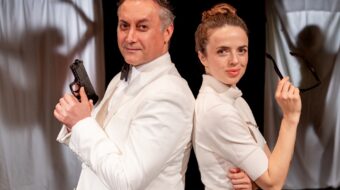
Soul, gospel, blues, jazz, R & B, funk, and rock. The music scene of the late sixties and early seventies was a zenith for these styles, and African Americans were a vital part of it all. The sheer volume of talent at the time was overwhelming. Wattstax, the 1973 film of the August 20, 1972, Stax Records benefit concert in Los Angeles (commemorating the seventh anniversary of the Watts riots) has probably been the most accessible and well-known document of outdoor African-American stage performances from this era…until now. Summer of Soul (…Or, When the Revolution Could Not Be Televised), a new music documentary of the 1969 Harlem Cultural Festival has recently premiered, contributing another very important record of African-American culture during that era.
Summer of Soul is directed by Ahmir “Questlove” Thompson, and it’s easy to recognize this was definitely a labor of love for the musician and filmmaker. Questlove, drummer for the Roots, the in-house band for The Tonight Show Starring Jimmy Fallon, flawlessly combines never-before-seen footage of the 1969 Harlem Cultural Festival with new commentaries, creating a truly essential and entertaining viewing experience. The archival performances within are extraordinary and easily stand on their own…but Questlove’s direction and dedication in telling the complete story of how this all came into being shines through brightly.
Summer of Soul contains an abundance of awe-inspiring material. We see iconic musicians on stage, alongside lesser known artists of equally exquisite talent. This is a feast for both ears and eyes, as the fashions and wardrobes of the era are on full, colorful display. Musically, culturally, and yes, politically, there is much to learn here.
A lone review of this film may not do justice in attempting to describe the raw energy and magic of the performers. Some of the headliners included B.B. King, David Ruffin, the Chambers Brothers, Mongo Santamaría, the Edwin Hawkins Singers, and a nineteen-year-old Stevie Wonder, who masters the drums in addition to the keyboards. Sly and the Family Stone, the racially integrated rock band that would go on to play Woodstock, also give an amazingly electrifying performance, including their multiracial anthem of unity, “Everyday People”.
Jazz aficionados will savor a performance clip of flutist Herbie Mann featuring Roy Ayers on vibraphone. Drummer Max Roach appears with vocalist Abbey Lincoln interpreting John Coltrane’s “Africa”. Max Roach’s son, Raoul Roach adds, “My dad and Abbey just didn’t see the civil rights struggle as an American thing, they saw the struggles in the Caribbean, South America, and in Africa all as part of a common struggle.” Hugh Masekela commands the stage, as the film describes how the South African musician always supported oppressed citizens worldwide. His son, Selema Masekela contributes, “My father realized there was this real hunger for Black Americans to feel and see and taste what it would be like to be African. He loved Harlem. He always wanted to be within the people. If it was poppin’ off somewhere where people were disenfranchised, disempowered, or needed support, it was like a tractor beam for him. Like, he had to go and be part of it.”
Gospel highlights include Mahalia Jackson singing “Precious Lord Take My Hand”, along with Mavis Staples (who shares heartfelt memories of her experience). The emotional energy of the film, in both archival footage and new commentaries, makes this a very powerful documentary. Reverend Jesse Jackson reflects back on that crucial time and is also seen in original stage footage with Ben Branch and the Operation Breadbasket Orchestra and Choir. Both Jesse Jackson and Ben Branch were in Memphis with Dr. Martin Luther King, Jr. at the time of the assassination on April 4, 1968, and Rev. Jackson shares his intense and solemn reflections with the Harlem audience.
Nina Simone, whose presence is so beautiful, confident, and strong, performs the razor-edged, politically charged “Backlash Blues” (lyrics by Langston Hughes), “To Be Young, Gifted, and Black”, and the David Nelson poem “Are You Ready, Black People?”. Embracing the Black Experience unapologetically, Nina Simone rallies thousands of African Americans in the audience, proudly holding nothing back. Many Latinos called East Harlem home, and Puerto Rican percussionist and bandleader Ray Barretto also stirs up powerful music and inspiring words about the shared community he was a part of.
The Harlem Cultural Festival took place on six Sundays beginning June 29 and ending August 24, 1969, in Mount Morris Park (now named Marcus Garvey Park). Total attendance for the concert series was over 300,000. Unbelievably, the video footage from the festival sat in a basement for over fifty years, unseen by the public after that summer. Summer of Soul co-producer Robert Fyvolent eventually acquired the rights from original producer Hal Tulchin, who failed in his own attempt to sell the material as a television special in 1969. Stevie Wonder hits the mark as he looks back and asserts, “The so-called powers that are or were didn’t find it significant enough to keep it as a part of history. Because it is a part of history.”
Director Questlove makes certain we experience near complete performances from many of the musicians onscreen. However, the political reality of the time is thoroughly discussed, interspersed with concert footage in a seamless style that makes the documentary as informative as it is entertaining. The Harlem Cultural Festival was a free, peaceful gathering in the midst of a very radical and sometimes violent time in history. The performers and the crowd were all well aware of this fact. The overwhelming majority of the audience, joyfully welcoming the performers, could proudly call the surrounding neighborhood of Harlem their home.
The Black Panther Party provided security, along with the New York City Police Department (which initially balked at providing officers before finally committing). The director, producer, and emcee of the event was charismatic promoter and lounge singer Tony Lawrence, described as the glue which brought the festival into being. John Lindsay, New York City mayor from 1966 to 1973, fully supported the festival. Mayor Lindsay is introduced onstage by Tony Lawrence as “our blue-eyed soul brother” and is seen having a good time with the audience.
There are new recollections from folks who lived in Harlem at that time and witnessed portions of the festival live, in addition to performers who took part onstage. Tears flow and emotions stir in these segments, as the Harlem Cultural Festival was such an important and timely event in their lives. Marilyn McCoo and Billy Davis Jr. of the 5th Dimension are quite affected as they fondly reflect back on their performance…so happy to connect with the Harlem audience.
Gladys Knight & the Pips give one of the most energized performances of the festival, rendering their hit version of “I Heard it Through the Grapevine”. Gladys Knight, reflecting emotionally, provides new commentary about her feelings of being a part of the Harlem Cultural Festival. Her words sum up best the collective feeling encompassing this seminal event, “But I knew something very, very important was happening in Harlem that day. It wasn’t just about the music. We wanted progress. We are Black people, and we should be proud of this. And we want our people, we want our people lifting us up.”
Summer of Soul (…Or, When the Revolution Could Not Be Televised) is showing in both theatres and on Hulu streaming. Experiencing the film up close on a big screen will enable viewers to feel as if they have been transported back to 1969 Harlem, surrounded by vibrancy, art, culture, and community. Thankfully, the long wait is over, and the world can now view and understand how essential and historic these concerts were in relation to the changing times.












Comments